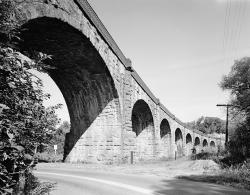
Opened in 1835, the Thomas Viaduct was the first multiple-arch, stone railroad viaduct in the United States. The viaduct is composed of eight arches each with a clear span of about 58 feet. The viaduct has an overall length of 614 feet and a height of about 60 feet above the Patapsco River. Construction of the viaduct began in August of 1833, and a ceremony marking its completion was conducted on July 4, 1835. The viaduct was constructed for the Baltimore and Ohio (B&O) Railroad and is named in honor Philip E. Thomas, who served from 1827 to 1836 as the first president of the B&O. The viaduct was designed by civil engineer Benjamin Henry Latrobe, Jr. (1806-1878), who held the position of assistant engineer of the B&O.
In the early 1830s, the Baltimore and Ohio Railroad began planning what would become the first rail line into the Nation's capital. The route from Baltimore to Washington D.C. required crossing the Patapsco River and surrounding plain at Elkridge and Relay, Maryland, with a structure of sufficient elevation and strength to avoid potential damage from flooding of the river. Further, the crossing required a curved railway alignment with a radius of about 1273 feet and an arc of 4.5 degrees, substantially complicating the design and construction of the viaduct.
In order to accommodate the curved alignment without skew arches, Latrobe adopted piers that were trapezoidal in plan. The width of the piers on the outside of the curve is greater than the width along the inside of the curve, and the lateral sides of the piers follow radial lines. Construction of the viaduct under difficult site conditions was undertaken by builder John McCartney with supervision by Caspar Wever, chief of construction for the B&O. The final cost of the viaduct was about $142,000. A monument in the shape of an obelisk was erected at the east end of the viaduct, commemorating the directors of the B&O, and the designers and builders of the viaduct.
During its construction the viaduct became known as "Latrobe's Folly" as many expected it would never be able to support its own weight of 63,000 tons of granite. However, upon its successful completion in 1835, the American Railroad Journal recognized its engineering significance by declaring it a "university" for the design and construction of railroad bridges. The uniqueness of Latrobe's design is noted in the 1888 edition of Mahan's Treatise on Civil Engineering as "one of the few existing bridge structures with a curved axis." The strength of Latrobe's design would be demonstrated in 1866 when the viaduct survived a major flood of the Patapsco River, which essentially destroyed the nearby Patterson Viaduct, an earlier B&O stone arch bridge designed and built by Wever and McCartney.
Throughout its history, the Thomas Viaduct has provided a critical rail link to Washington D.C. As part of the only rail line into the capital during the Civil War, the viaduct was heavily guarded by Union troops. The Thomas Viaduct continues to carry freight trains of substantially greater weight than those for which it was originally designed, as well as passenger trains between Baltimore and Washington.
Resources
- Dilts, James (1993) The Great Road: The Building of the Baltimore and Ohio, the Nation's First Railroad, 1828-1853 . Stanford University Press: Stanford, California.
- "Baltimore & Ohio Railroad, Thomas Viaduct" (1984) Historic American Engineering Record, HAER No. MD-3. Prints and Photographs Division, Library of Congress. Washington, D.C.


